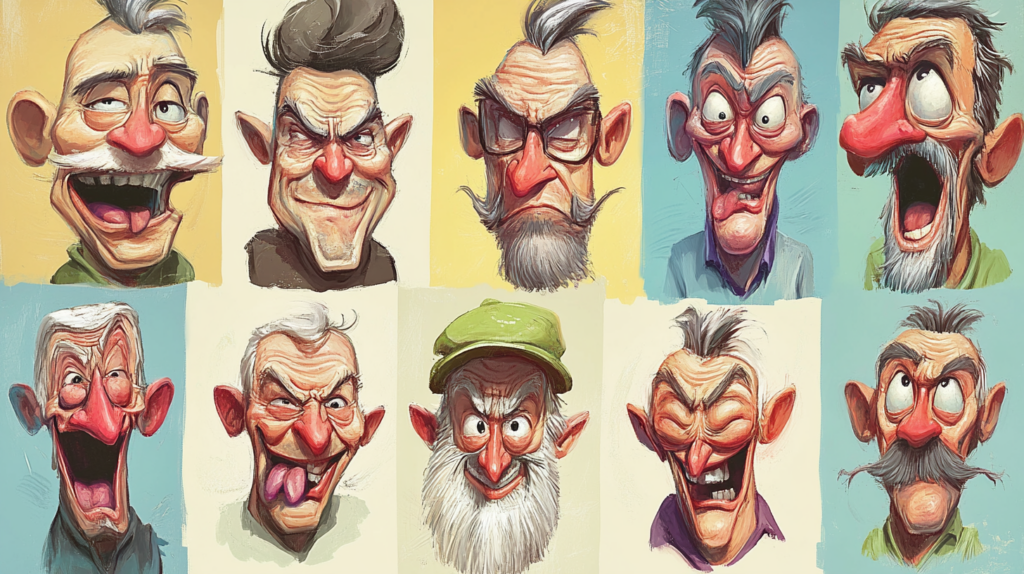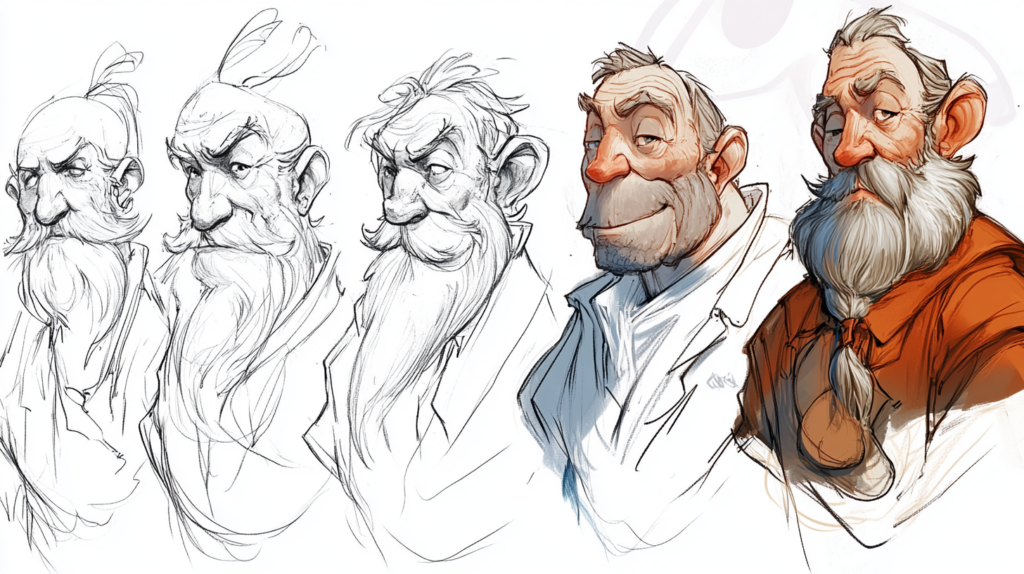Art styles in cartooning refer to the distinct visual approaches that artists use to convey their stories, ideas, and characters. These styles vary widely in terms of realism, abstraction, and exaggeration, and each brings its own unique feel and emotional tone to the work. From hyper-realistic art to simplistic cartoonism and bold abstract forms, the art style chosen by a cartoonist shapes how the audience experiences the narrative. As a cartoonist, I have worked with various art styles, each offering its own creative possibilities for expression. This article explores different art styles used in cartooning, such as realism, cartoonism, and abstraction, and explains how these styles impact storytelling and audience engagement.
What Is an Art Style in Cartooning?
Art style refers to the overall visual aesthetic and approach an artist uses to create a cartoon. This includes the level of detail, use of color, line work, and the portrayal of characters, settings, and emotions. In cartooning, art styles can range from highly detailed and realistic to abstract and exaggerated, with many variations in between. The chosen art style influences how the audience interprets the tone of the story, relates to the characters, and engages with the cartoon’s world.
Key Characteristics of Art Styles in Cartooning:
- Line Work: The thickness, boldness, or softness of lines used to define characters and environments.
- Detail Level: The amount of detail included in the characters, backgrounds, and objects within the scene.
- Exaggeration: The degree to which features like facial expressions, body shapes, and actions are exaggerated or simplified for effect.
- Color Usage: How color is applied, from vibrant and bold to muted and subtle, to convey mood and tone.

Examples of Art Styles in Cartooning:
- Realism: A highly detailed and lifelike portrayal of characters and environments, such as in graphic novels like Maus.
- Cartoonism: A simplified, exaggerated art style with bold lines and exaggerated features, seen in cartoons like The Simpsons.
- Abstract: A non-representational style that focuses on shapes, colors, and emotions rather than realistic portrayals, such as in the experimental animation Yellow Submarine.
Popular Art Styles in Cartooning
There are several prominent art styles used in cartooning, each with its own set of characteristics and uses. Below, we explore some of the most common styles, their features, and their impact on storytelling.
1. Realism
Realism in cartooning is an art style that emphasizes lifelike portrayals of characters, environments, and actions. This style often features detailed anatomy, accurate proportions, and realistic shading and lighting. Realism aims to depict the world as it appears in real life, making it a great fit for stories that require a more serious or grounded tone, such as historical or biographical comics.

Key Characteristics of Realism:
- Detailed Anatomy: Characters are drawn with realistic proportions and features.
- Shading and Lighting: Realistic light and shadow are used to add depth and dimension to the artwork.
- True-to-Life Representation: The environment, objects, and characters are depicted as close to real life as possible.
Example: “Maus” by Art Spiegelman is a graphic novel that uses a realistic art style (despite anthropomorphized characters) to tell the serious, historical story of the Holocaust. The detailed shading and lifelike proportions lend weight and seriousness to the narrative.
Personal Insight: Realism allows me to tell stories that are grounded in real-world experiences. When I want to evoke a sense of seriousness or authenticity, I lean toward a more realistic style to help connect the audience with the gravity of the story.
2. Cartoonism
Cartoonism is the most iconic and recognizable art style in cartooning, characterized by simple shapes, exaggerated features, and a focus on humor or light-hearted storytelling. Cartoonism often uses bold lines, bright colors, and simplified character designs that emphasize emotions and actions over realism. This style is particularly effective for comedy, satire, or children’s cartoons, where the focus is on entertainment rather than realism.
Key Characteristics of Cartoonism:
- Exaggerated Features: Characters often have large heads, expressive eyes, or exaggerated limbs for comedic or emotional effect.
- Bold Lines: The artwork typically features thick, strong lines that clearly define characters and objects.
- Bright Colors: Color is often vibrant and used to enhance the fun or whimsical tone of the story.
Example: “The Simpsons” is a perfect example of cartoonism, with its exaggerated characters, large eyes, and simplistic designs that emphasize humor and absurdity. The bright, bold color palette enhances the show’s satirical and humorous tone.
Personal Insight: Cartoonism is a great style for exaggeration and humor. I often use this style when I want to create characters that are instantly relatable and funny, relying on expressive faces and exaggerated actions to tell a story in a lighthearted way.

3. Abstract
Abstract art in cartooning is a more experimental style that focuses on shapes, colors, and forms to convey emotions or ideas rather than realistic representations of characters and settings. Abstract cartoons often break away from traditional storytelling methods, using visual metaphors and non-linear narratives to create a more interpretative experience for the audience. This style is ideal for stories that focus on emotions, surrealism, or symbolic storytelling.
Key Characteristics of Abstract:
- Non-Representational Forms: Characters and objects may not resemble real-world counterparts, focusing instead on shapes or colors that convey feelings or concepts.
- Symbolism and Metaphor: The artwork often includes visual metaphors or abstract representations of emotions, thoughts, or themes.
- Unconventional Storytelling: Abstract cartoons may not follow a traditional narrative structure, relying more on visual impact than plot.
Example: “Yellow Submarine” (the 1968 animated film) uses abstract art to tell a surreal, psychedelic story. The characters and settings are depicted in bright, unconventional shapes and forms, creating a dreamlike visual experience.
Personal Insight: I enjoy using abstract styles when I want to create something more conceptual or symbolic. This style frees me from the constraints of realism and allows me to explore deeper emotional or thematic ideas through visual experimentation.
4. Minimalism
Minimalism in cartooning is an art style that focuses on simplicity, using as few lines, shapes, and colors as possible to convey characters, actions, and settings. Minimalist cartoons are often clean and uncluttered, with a strong emphasis on efficiency and clarity. The simplicity of the style allows the story to shine through without unnecessary distractions. Minimalism is frequently used in webcomics, editorial cartoons, and humor-based comics.
Key Characteristics of Minimalism:
- Simple Lines: Characters and objects are drawn with very few lines, focusing on essential shapes and forms.
- Limited Color Palette: Minimalist cartoons often use a small range of colors, or sometimes none at all, relying on black and white for clarity.
- Focus on Clarity: The art is straightforward and easy to understand, with no extraneous details.
Example: “xkcd” is a popular webcomic that uses a minimalist art style, featuring stick figures and basic line drawings. The simplicity of the art allows the humor and intellectual content of the comic to take center stage.
Personal Insight: Minimalism challenges me to focus on what’s most important in a scene. I love how a few simple lines can be enough to tell a story or convey an idea. It’s a great style when the message or humor needs to be clear and immediate.

5. Grotesque
Grotesque cartooning is an art style characterized by exaggerated, often distorted features that are intended to provoke a sense of discomfort, humor, or horror. This style is commonly used in satirical or dark humor comics, where the characters’ strange, disproportionate designs reflect the absurdity or darkness of the story. The grotesque style plays with the line between the comical and the unsettling, using exaggerated proportions to make characters memorable and striking.
Key Characteristics of Grotesque:
- Exaggerated Proportions: Characters often have overly large heads, limbs, or facial features that can be unsettling or bizarre.
- Distorted Faces and Bodies: Features are exaggerated to the point of being unnerving or strange.
- Dark or Absurd Humor: Grotesque cartoons often use dark humor, satire, or absurdity to tell their stories.
Example: “Ren & Stimpy” is an animated series known for its grotesque art style, featuring exaggerated and often grotesque close-ups of characters’ faces to enhance the absurd humor and dark tone of the show.
Personal Insight: Grotesque art allows me to push boundaries and play with exaggerated, almost surreal character designs. It’s a fun style for satire and dark comedy because it amplifies the absurdity of the characters and situations.
6. Manga-Influenced Style
Manga is a popular comic art style originating from Japan, known for its distinctive visual features, such as large expressive eyes, dynamic panel layouts, and detailed backgrounds. Manga often uses a balance of realism and stylization, combining expressive characters with carefully rendered environments. This style is known for its ability to convey intense emotions and action while maintaining a high level of detail in character design and background work.
Key Characteristics of Manga:
- Large, Expressive Eyes: Characters often have oversized, expressive eyes that convey emotion.
- Dynamic Action: Manga uses exaggerated motion lines, angles, and panel designs to depict fast-paced action or high-energy scenes.
- Detailed Backgrounds: Environments are often highly detailed, contrasting with the stylized character designs.
Example: “Naruto” is a well-known manga series that uses dynamic character designs, dramatic expressions, and detailed backgrounds to tell an epic, action-packed story.
Personal Insight: Manga’s unique style allows for a balance between emotional depth and intense action. I find it inspiring because it blends stylization with intricate detail, making it perfect for stories that require both drama and visual complexity.

The Impact of Art Styles on Storytelling
The art style chosen for a cartoon significantly impacts how the story is perceived and understood. Here are a few ways art styles influence storytelling.
1. Setting the Tone
The art style sets the emotional tone for the story. For example, a cartoon with a minimalist, clean style might feel more lighthearted or whimsical, while a story told with a highly detailed, realistic style might feel more serious or grounded.
Example: A minimalist webcomic about daily life might feel calming and relatable, while a dark, grotesque comic might evoke discomfort or tension, reflecting the themes of the story.
Personal Insight: I always consider the tone of the story before choosing an art style. If the story is comedic or light, a more exaggerated, cartoonish style fits. For serious or emotional stories, a realistic or detailed approach helps connect the audience to the gravity of the narrative.
2. Enhancing Emotional Connection
The way characters are designed can help readers connect emotionally with them. For instance, large, expressive eyes in cartoonism or manga styles can immediately evoke empathy, while more abstract or grotesque designs might challenge the reader to interpret the emotions differently.
Example: In a manga-style comic, a character’s oversized, teary eyes can instantly communicate sadness or despair, making the reader feel more connected to their emotional journey.
Personal Insight: Expressive features are key to connecting readers with characters. Whether it’s through exaggerated eyes or subtle body language, the way characters are drawn impacts how much the audience relates to them emotionally.
3. Shaping Audience Perception
Art styles influence how the audience perceives the world of the cartoon. Realistic styles ground the story in reality, making it feel more immediate or serious, while abstract or exaggerated styles can create distance, focusing more on themes or emotions rather than realism.
Example: A realistic graphic novel like Persepolis uses detailed, lifelike art to ground the reader in the real-world struggles of the protagonist, while an abstract cartoon might focus more on symbolic representation of those struggles.
Personal Insight: I use art styles to shape how I want the audience to see the world of the story. If I want them to feel like they’re experiencing something real and immediate, I use more realistic detail. If I want to convey emotions or themes in a more abstract way, I simplify or distort the visuals.

The Bold Art Styles in Cartooning
Art styles in cartooning are essential to how stories are told and how audiences engage with them. From the exaggerated, humorous forms of cartoonism to the intricate details of realism or the experimental freedom of abstract art, each style brings something unique to the table. The art style not only shapes the visual appeal of the cartoon but also enhances the storytelling by setting the tone, creating emotional connections, and influencing how the story is perceived.
Final Thoughts:
As a cartoonist, choosing an art style is one of the most important decisions I make for any project. Each style offers different strengths and challenges, and it’s always exciting to see how the right art style can transform a story.
Call to Action:
For fellow artists, I encourage you to experiment with different art styles. Try using a more realistic approach for a grounded story, or push the boundaries with abstract art for a more conceptual project. For readers, think about how the art style of your favorite cartoons influences your experience—how does it shape your perception of the characters and the story? Share your thoughts in the comments below!




